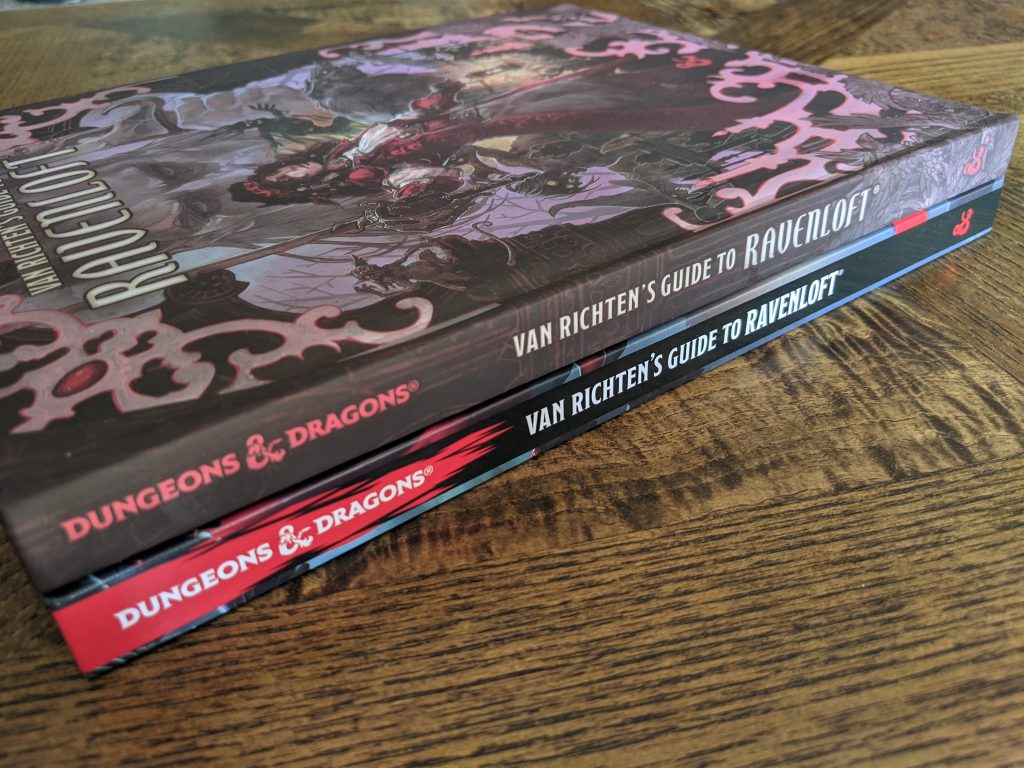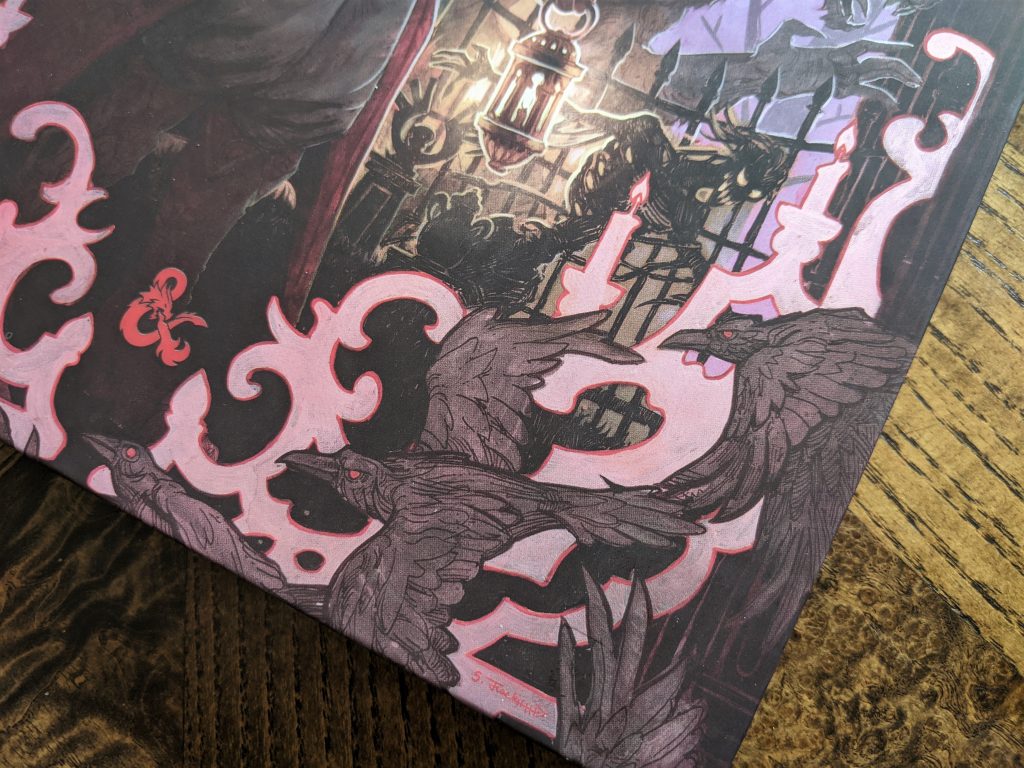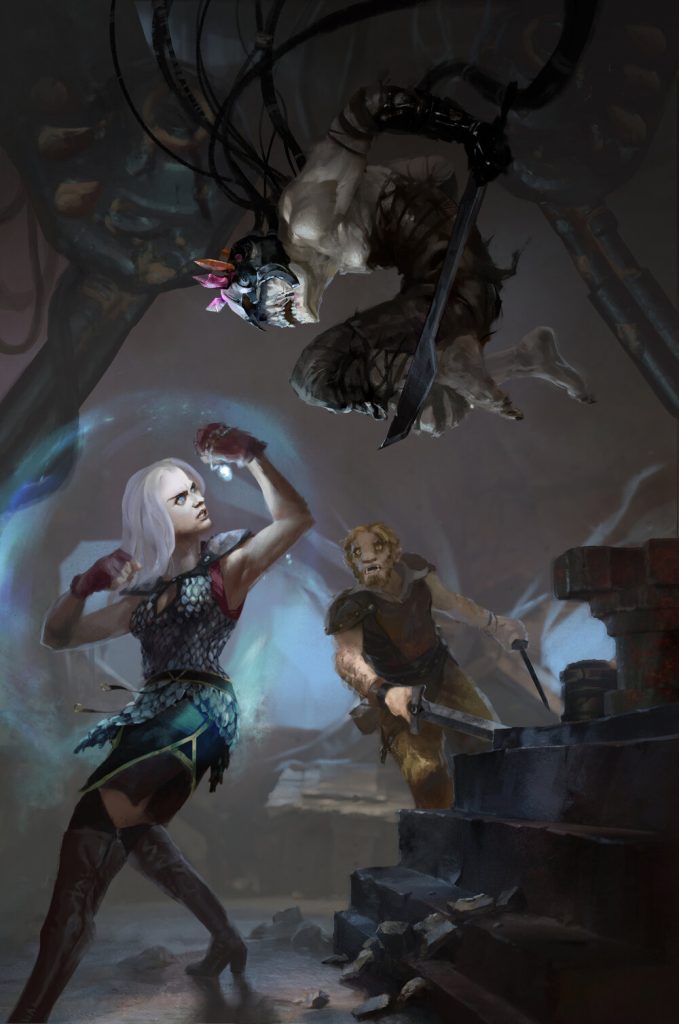The new release from Wizards of the Coast details not only 17 domains of dread (with framework of 22 others), but dives into the mechanical workings of horror as a genre and how you can maaaaaaaaybe make it work for 5e D&D. Lets find out if it’s worth your time, attention, and precious monies.
About This Review
It needs to be said that Curse of Strahd was and is my favorite release from Wizards of the Coast. A thematic book dripping with love of the horror genre and unashamedly leaning into the quirkiness that surrounded timeless horror such as Dracula and Frankenstein. When I heard about Van Richten’s Guide to Ravenloft, I was excited for approximately 8 seconds – enough time for me to read “39 new domains of dread.”
Pardon, but Ravenloft is a castle… in Barovia, which is a Domain of Dread named after the City and Valley of that place. Strahd lives in Castle Ravenloft overlooking Barovia in the valley of Barovia in the Domain of Dread known as Barovia, so what the hell?
Truth is – I suspect they used Ravenloft to grab your attention – name recognition. It’s quick, it’s ingrained. This book basically explains that NOW and moving forward: Strahd lives in Castle Ravenloft overlooking Barovia in the valley of Barovia in the Domain of Dread called Barovia in the expanse of Mist called Ravenloft.
My eyes want to roll out of my skull, because “Van Richten’s Guide to the Domains of Dread” would have been perfectly fine – but alas. We are here. So I do think a bit of the cynicism will seep into my review of this book, as well as one simple, immutable fact (in my opinion): 5e and horror do not mix. 5e characters can walk through a horror inspired setting (like the Frozen North, Barovia, etc) but the system was not built and is not flexible enough to tell horror stories in a way that doesn’t completely subvert the system in its entirety. Imagine playing Alien (1979 horror classic) with one of the crew members sporting a 32 passive Perception and a tiny hut spell to keep them perfectly safe for 8 hours. It doesn’t translate.
So – I’m going to tell you what this book has in it, what I think is cool and what works, and what I think is uncool and doesn’t work. Chances are high the book has already gotten enough of your attention to merit your purchase anyway, but lets look at what you’re walking into together!
TL;DR Review
If you plan on making your own PDFs or home games and just need a stepping stone to get yourself started, you might enjoy Van Richten’s Guide! For everyone else, this will be a shelf ornamentation at best. There’s a handful of really useful ideas and a cool horror toolkit in chapter 4, but honestly the rest of the book feels incomplete – nothing left me feeling impressed or pleased, only confused why it was so choppy.
Me, 2021
PS: I did a Video flipthrough of the book with and without commentary over on Youtube. Check it out if you want additional punishment.
Covers
As always there is a Standard and Special Edition cover. Lets peep those first.
Standard Cover
I’m actually quite pleased with how bright, vibrant, and thematic the standard cover is! Just look at how borderline photorealistic Ez is! The blacks aren’t crushed and ugly, the colors are vibrant and eye catching, great composition – love it!


Special Edition Cover
This cover has the best foil since Xanathar’s Guide to Everything. It’s got A cool style and interesting composition, and I even think the BACK looks cooler than the front, but what’s weird is – the whole thing looks kinda muddy? It’s most visible when comparing the spines of the two covers: one is so sharp and crisp with full blacks and bright white, the other looks kinda gray and the matte finish is a little dull. The lettering looks more fuzzy and dull because of it – idk. I’m not sure what happened, but that lack of contrast just doesn’t work for me.


The Book Itself
So this is the first time I’d give a WotC book release a failing grade. My book had stuck pages, misprints, over inks, some of the pages weren’t event cut correctly. The books are both horribly difficult to keep open due to spines as hard as wood. The Special Edition cover has a GREAT theme, but looks really muted and muddy with flat colors and fuzzy gray blacks.
I’m sure they’ll iron out all those problems sooner or later, but you may end up having to exchange these books if any one of the above problems are not to your liking – and paying full price, they shouldn’t be.
And, again… where the hell is the Index?
Chapter 0: Welcome to Ravenloft
As I have said, Ravenloft is now the new name for the domains of dread as a whole /and/ the castle in Barovia. Likewise we see Ezmerelda d’Avenir subtly changed from a monster slayer to an “investigator” named “Ez” predominantly through the book. I’m unsure /why/ that choice was made, but it shouldn’t stick in too many craws.

Chapter 0 does a good job of setting up some fundamentals: what is horror, how fear can influence a game, aspects of horror and fear you can and cannot control, but I do wish a little more time was spend giving examples and going into the vocabulary and tone of Horror. There’s a marked difference between something like Hostel or Saw, which are gory, loud, and shocking – and horror like The Blackcoat’s Daughter or The Witch, which are suspenseful and chilling. Knowing how to present details to the players can mean the difference between your Count Strahd von Zarovich being called a “simp” and having the smell of farts wafted over him constantly and having your Count make the players’ blood run cold whenever he decides to appear to them.
This introduction also delves into the specifics of Ravenloft (it’s infinite, there’s no telling what you’ll find, none of the rules matter in the domains, nothing is safe, etc etc), but specifically the land of mist that is the blanket canvas for all of the domains: the Dark Powers that caused the demiplanes to form in the first place, the mists that trap people inside them, the domains themselves, and the Dark Lords (like Strahd) who the Dark Powers feed off of in perpetuity.
While that sounds epic and incredibly insightful, I’m sorry to report that the huge majority of this chapter circles back around to the central idea of “enigmatic.” No one knows why the domains were made, Make it your own! No one knows why the Dark Powers trap people, Make it your own! No one knows why the Mist enshrouds the area, Make it your own! BE AWARE, dear reader, that without mystery, Horror cannot exist. If everything about these powers and mists and domains were explained to the players, it would immediately sap much of the dread from them – they would become another facet of life. Why Michael Myers KEEPS GETTING UP, refusing to die, hungry to kill – THAT’S the horror of the situation. But I would be lying if I said that I did not hope for more insight into these beings, this place. More information is given inside Curse of Strahd than here, which is a bit of a bummer.
Chapter 1: Character Creation
This chapter takes a wide-angle view of who the hell would find themselves here and why. Trinkets, Backgrounds, Dark gifts, Subclasses, Lineages (akin to ‘races’ in the PHB), and “Haunted Heroes” give a pretty deep and wide toolbox for players to inject a little horror into the story themselves. Here are my interesting talking points:
Haunted Heroes
This entire section is devoted to the noblest of all tasks: convincing players to PLAY ALONG with the horror of a horror game. How to not make your character implacable, how to limit jokes and embrace setbacks. This small 2.5 page section could be an entire full-length release from WotC and I’d support it completely. It’d make for an amazing “zine” covering different types of games and tips for enjoying them. A good addition, if a little sparse.
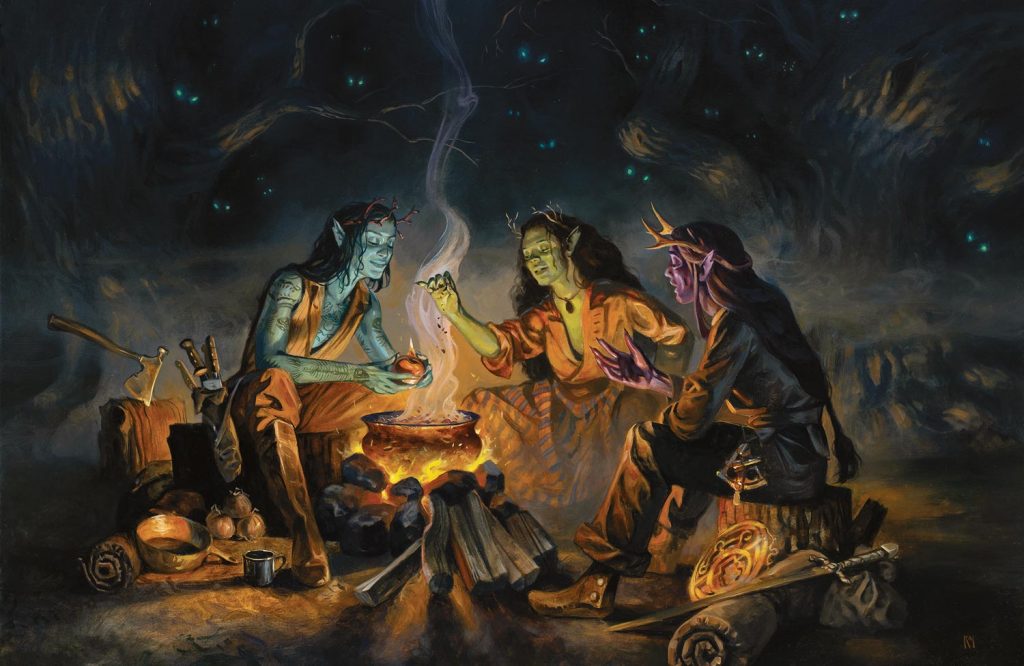
Lineages
So lineages work like this: you choose a race (human, fantastical, whatever) and if you want to use a Lineage from this book, you cast aside everything but the description of your race and embrace the lineage. You’re not a half-elf Dhampir, you’re JUST a Dhampir. I like it, I think it works well, but it does get a bit messy trying to juggle the already established 84,000 races and these new non-race additions. However, I think they did a good job attempting it.
A quick look at your options:
- Dhampir are half ‘vampires’, stuck between the living and the dead. More ghoulish than vampiric, they start with potent abilities including the ability to keep aspects of your previous race, the lack of need to breathe, the ability to climb and walk along surfaces, and a nasty vampiric bite close in style to that of the lizardfolk’s hungry jaws.
- Hexblood is a lineage twisted and reformed by magic – styled after a witch, I’d say. They are absolutely insane and make my head hurt. Fey by nature, they have darkvision, access to racial skills and bonuses including movement, limited telepathy or scrying using your removed body parts, and both disguise self and hex. There are subclasses with less versatility.
- Reborn, on the other hand, are Frankenstein’s Monster-like humanoids that have been brought back from the other side, sometimes with ghostly or phantom appendages and a lack of their previous grace and understanding. They gain poison and disease resistances, advantage on death saves forever, don’t need food, water, or air, and don’t need to sleep or even meditate, just remain still. They even get visions from death to help their ability checks. This lineage removes 7/8ths of the exploration/survival pillar of play – don’t pick it unless your DM openly says they do not care.
Yeah, so all of those are insane. I can only imagine min/maxers and max/maxers frothing at the mouth over the ability to completely derail traditional games with these options. A big part of my own Curse of Strahd game was keeping people fed and rested – constantly hounded by wolves, ravens, and vampire spawn unto the brink of exhaustion. With these? Nah, it’s cool. I’ll go sit on the bottom of a river for 4 hours and get my spells back real fast. Oof. My sympathies.
Dark Gifts
One of the big draws for the Amber Temple in Curse of Strahd is the promise of power – the temptation to accept these insane deals, knowing that the gifts of the Dark Powers could save your life. Likewise there are some ideas for how Dark Gifts could come into play that I really like, and the gifts themselves seem.. fine? A little complex, I think? Many of them require rolling on a chart pretty regularly whereas dark gifts in Curse of Strahd were more like: “Cast lightning bolt 3 times without expending a spell slot. Your eyes melt out of your goddamn face.”
Here, an example dark gift is: You agree to be haunted by ghosts who endlessly whisper at you, but you can cast message at will, when you’re hit with an attack you can cause the ghosts to shout at your attacker and increase your AC, and you get completely screwed and have to roll on a punishment chart whenever you roll a 1.
I expected there to be like 50 or 60 dark gifts in this portion of the book, since so many were packed into the Amber Temple portion of CoS, but there are only 8 since they all use 2 charts and have multiple abilities.
I’d probably rate this section a… 4 out of 10? Some of the effects are cool and the flavor/inspiration is GREAT, but they’re so long and some seem so cumbersome I doubt I’d use any? But some of you may have parties that LOVE that sort of thing – so you may get more use out of it than I would!
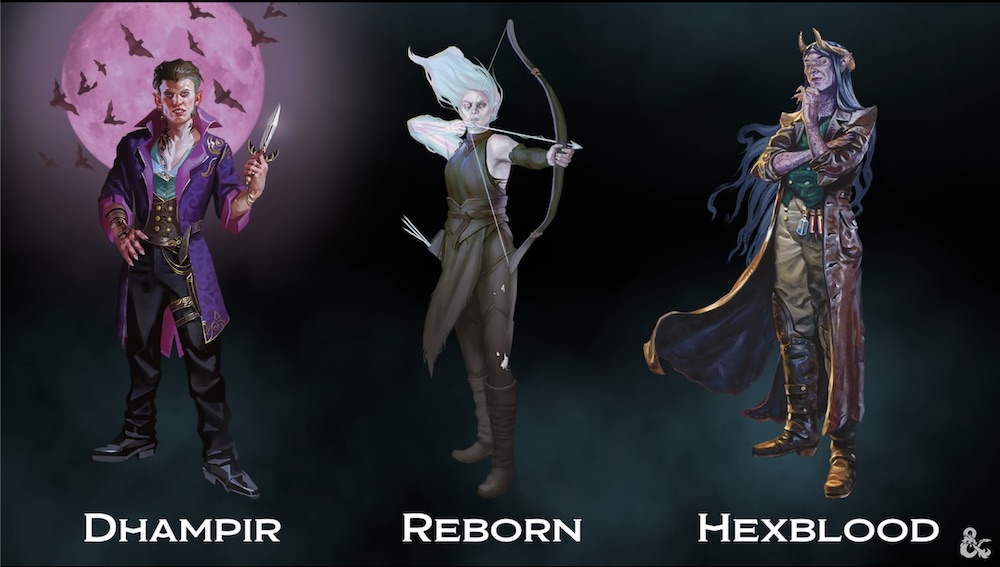
Subclasses
Focusing on the theme of horror, there are two (2) new subclasses to choose from.
- Bard: College of Spirits lets you step into the lane of clerics a bit at 3rd level with access to guidance for free and die bonuses to all damage and healing, plus a slight flavor of Wild Magic Sorcerer with the “Tales from Beyond” table. Some boons, some banes, all at random and fueled by your inspiration dice. In later levels the College of Spirits can get spells from other classes through a ritual with “Spirit Session.”
- Warlock: The Undead has an expanded list of spells that are good and pretty thematic, and can manifest their undead patron’s power to take on a new form with some okay buffs and bonuses such as temp HP and stuff with fear. The big sell here, I think, would be the ability to no longer need air, food, or sleep, and huge damage boosts and immunities at higher levels, though they’re all tied to once per long rest features.
Backgrounds
Background are generally hit or miss and these I think are all serviceable. Most of them are written and stylized to slot into Ravenloft as a setting, such as Mist Wanderer and Trauma Survivor. I’m actually a bit befuddled that SO MUCH of the book is devoted to these backgrounds and features, but really – backgrounds are an important part of establishing your character’s flavor and representing them. Some cool features, thematic flavor, interesting tables – this is a good section!
Horror Trinkets
Obviously this is fantastic. Never enough weird stuff to find out in the wide, wide world.

Chapter 2: Creating Domains of Dread
This chapter takes you step by step through how to populate a Domain that mirrors what you find in this book (which you’ll hear about in the next chapter.) I think there’s some great tidbits here, particularly where the book suggests you borrow “sinister reflections” from your party when making your Dark Lord and establishing the Dark Lord’s past. After all, what is Dracula without his castle and history? Just some creep who wants to bite people. That’s no good.
I feel like this chapter is a goldmine but only for those willing to get on their knees with a sieve and find the little bits and pieces that spark inspiration in them. If you’re running a homebrew world or even establishing a big bad for a published adventure, following through this chapter might develop them further in your own mind, much like Xanathar’s Guide did for player characters’ backgrounds. The tables and rules for constructing a domain of dread and the genres of horror listed and qualified will help newer DMs and ye olde’ grognards by reminding them that VERBIAGE can be the difference between acceptable and unacceptable occurrences at the gaming table.
When you sit down to play a Gothic Horror game, knowing that Gothic horror very seldom involves body mutilation or cosmic entities (like Body Horror and Cosmic Horror do), it really can make a huge difference.
Having said that, as I look through some of these charts I’m left wondering: “Wut?” – some of these are so far off the rails they’re floating among the stars, and I’d be hard pressed to find a DM with the attention and perseverance to play an entire campaign in “a country of red muscle, with bleeding eyes embedded in the hair-strangled trees.” Like, cool for a creepy vision, but a setting? That’s a hard sell for most people.

Chapter 3: Domains of Ravenloft
Twelve there were set out from Ravenloft, yet only eleven there are here. Tell me, where is- wait, where am I? Oh yes – THE MISTS!
This chapter gives a brisk overview of 17 [SEVENTEEN] domains of dread (including Barovia) and a rapid dash nugget of description on 22 “other” domains that are 1-2 paragraphs. The twelve domains and my succinct thoughts on them follows, but each and every one of them is the bare minimum in terms of development. They’re ideas to leapfrog off of, not fully functional locations with developed narratives, so if you’re not prepared to dig in deep and develop each and every one of them – these will only function to spark some inspiration for you. If you sit down at a table expecting to run your party through a domain of dread, you’re going to be sorely disappointed and potentially irritated. You’ve been warned.
Barovia domain of the First Vampire. This book does nothing noteworthy that Curse of Strahd didn’t do much more completely and with more flare and attention to detail and building. There’s 2-3 mentions of other domains and their relationship to Strahd here, but it also says to use a “vampire stat block” when he’s a vampire spellcaster, so Idk what to believe. They did an okay job making a teaser of Barovia, but it feels hollow without the rich tapestry of the rest of Barovia and the glorious NPCs therein.
Bluetspur, domain of Alien Madness. Bluetspur is rife with scars of “protean apocalypses,” mental wounds for its denizens, and physical scars for those who live there. It’s inspired, I think, on At the Mountains of Madness by HP Lovecraft (the racist xenophobic shithead that he was, his works have inspired millions through generations – even I love his work but would spit on his face if given the chance.) It’s a realm of ilithids, a god-brain, and twisting memories. Huge electrical storms wrack the entire landscape in a wonderfully descriptive establishment of just how weird this place is. But it relies a lot on the manipulation and alteration of PC memories, which is a tricky, irritating ordeal that I fear only seasoned storytellers will be able to handle efficiently.
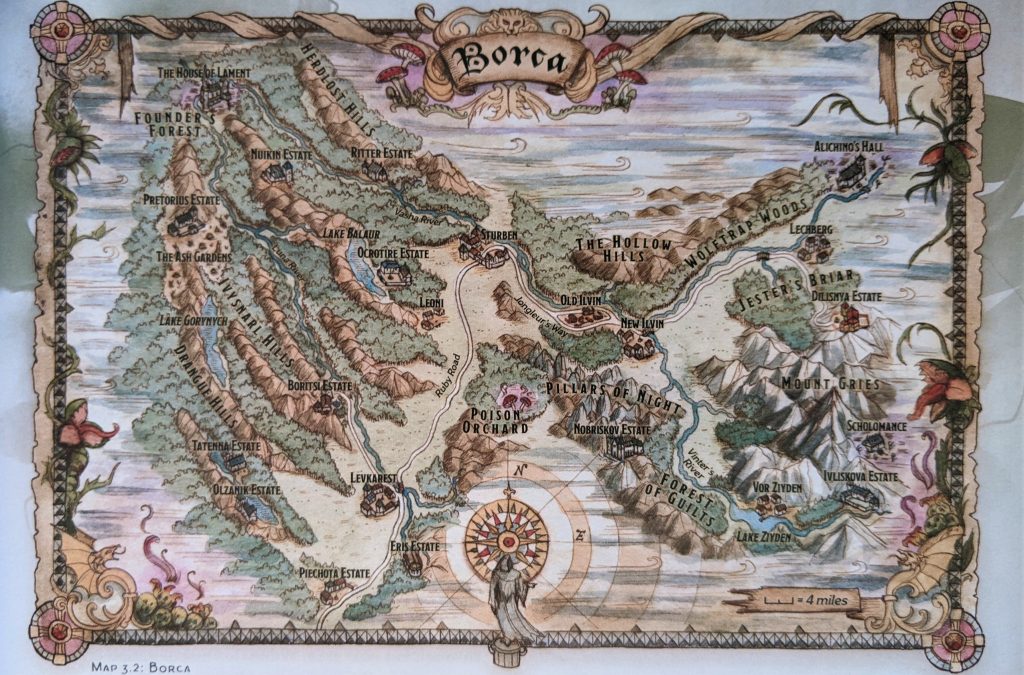
Borca, domain of Desire and Deceit. The showstopper here is the INCREDIBLE map by Francesca Baerald – my lord, it’s so gorgeous. 10/10 I want more like this. The domain itself is a Gothic horror setting full of noble families, NPCs, and a lot of political and cultural upheaval. It’s a little more developed in terms of narrative inspiration than Bluetspur, but may seem a little dry to people by comparison. I think a lot could be done with this domain.
The Carnival, a Domain of Wonders. Carnivals and mummery is a beloved horror trope and what we’re given here works well for that with big top shows, several peculiar NPCs, and a few noteworthy descriptions and the only magic item found in this book (a holy avenger sword). It’s just so short and there are so few adventure hooks, the real draw here is the list of NPCs.

Darkon, domain on the Brink of Destruction. This domain is being consumed by the mist, turned hungry (called “the Shroud”). Some old school gamers may recognize the name Azalin Rex, but he is /not/ in this domain – instead the wizard-king who ruled BEFORE Azalin is here (Daraclus Rex). This place is bombastic, reviled, and has a gargantuan list of secrets in the form of 9 separate tables. So if exploration and uncovering mystery is your thing, maybe this one will inspire you.
Dementlieu, domain of Decadent Delusion. This domain focuses on psychological and fantastical horror. Again – a PHENOMINAL MAP! Jared Blando – well done! Holy crap. The sprawling city that makes up the bulk of the domain is great, and the centerpiece is a masquerade ball. That is interesting, if underdeveloped. I’d love to see a full-length version of this place as a tier 2 adventure.
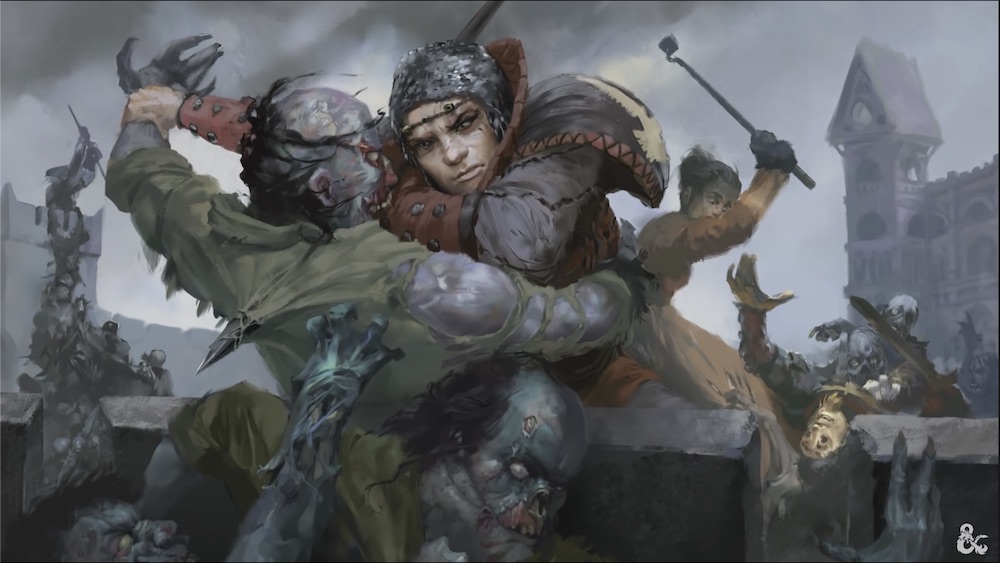
Falkovnia, domain Besieged by the Dead. Another Baerald map and the coolest subtitle ever start this one on the right foot. The entire place is SWARMING with undead. This is the Tabletop equivalent of the game They Are Billions, where swarms of undead come from the mist every so often and bring devastation with them, including rules for zombie sieges. It’s legitimately the coolest thing to me. Even the choice to make the Dark Lord relatively weak (a knight) is wonderful. I may actually WRITE an adventure for this domain, mark my words.
Har’Akir, domain of the Ancient Dead. This domain focuses on mummies and is keyed to a wonderful Egyptian style. This setting is more focused on the unique and interesting locations, I feel, and is written very well. It’s got a lot of adventure hooks appended to the end, but those come at the cost of a lot of actionable information. Another wonderful idea not quite given the length it needed or deserves.
Hazlan, domain Doomed by Magic. Our second disaster horror setting, this one is developed around the idea of explosive magical disasters and tiered oppression of spellcasters. Powerful casters subscript weaker casters into service and those without magical prowess are left to fend for themselves like rats on a sinking ship. This reminds me of Magic The Gathering’s Zendikar setting – including the elaborate art style and creepy idea of a dominated and controlled purple worm named Gravedrinker. This domain does a great job of tightening its scope around the dark lord Hazlik and his machinations, which was a wise choice and what made Barovia/Ravenloft stand the test of time.
I’Cath, domain Trapped in a Dream. An Asian inspired domain, I’Cath focuses around the dynamic of living between the real world and a dream world. Imagine if when you fell asleep, you lived your entire normal life in the dream world, then woke up – eventually every person in I’Cath loses track of if they are awake or asleep. Of all the domains, this one has the most interesting and peculiar premise. And Tsien Chiang, the domain’s Dark Lord is so peculiar and strange. There are echoes of postcolonial upheaval and oppression woven into the entire idea of the domain. Whether purposefully done or a happy accident, that scar seems to ripple into every part of the domain. If any part of this domain speaks to you, it could prove to be a wonderful starting place to build a campaign.
Kalakeri, domain of Betrayal and Revenge. This political-centered domain centers on the balance of power between siblings and offers a cool idea: only the Dark Lord who controls the Sapphire Throne can control the demiplane. A sizable portion of the domain is focused on tracking renown between the loyalists and the rebels and who the party sides with. At the very least, those ideas and charts can be used almost anywhere with a little bit of retooling.
Kartakass, domain of Tarnished Dreams. This domain is what you’d get if you mixed Shakespeare and The Wolfman. It has high ideals and, like many other domains, only gives you a brief overview, anchored through stylistic verbiage. It’s a land of bards and performances, werewolves and gray morality. A really interesting idea I wish had another 20 pages to flesh out (though I’m sure you’re sick of me repeating that sentiment over and over already).
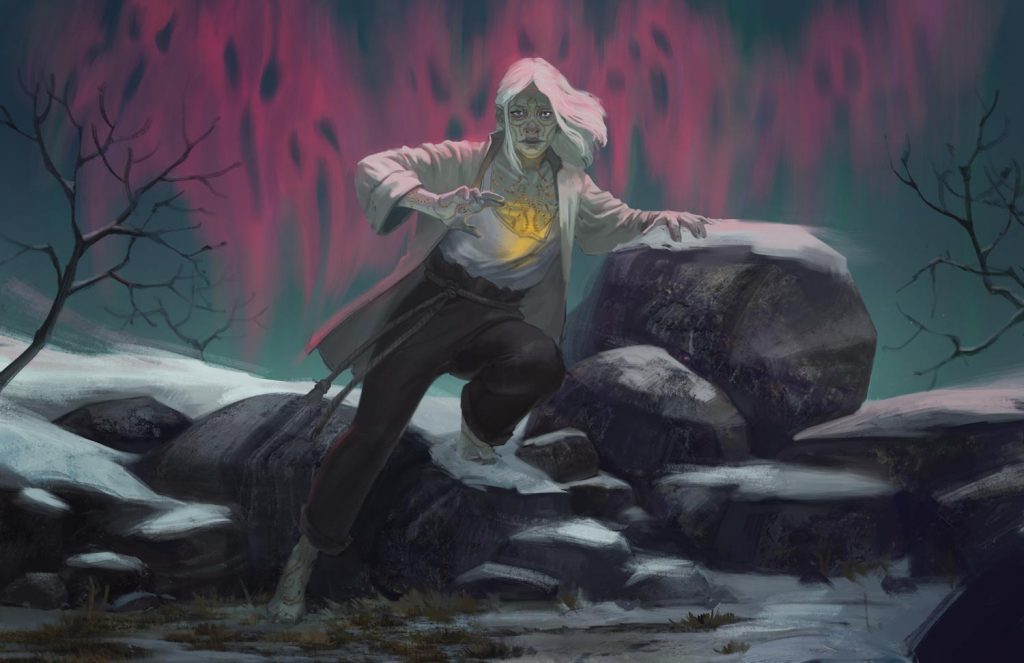
Lamordia, domain of Snow and Stitched Flesh. So, Frankenstein is one of my favorite books – so this gets special mention for giving me those vibes. It’s a domain full of scientists and scholars and spellcasters all hell bent on making life an unimpressive commodity. There’s a lot of man-vs-nature stitched into this setting where roaming beasts, starvation, harsh cold, etc seem more of a threat than even the Dark Lord, who uses the statistics of a CR 2 Spy – but it’s just weird enough and flavorful enough that I think this domain could be a great addition to people running Rime of the Frostmaiden or even Curse of Strahd (you could get here by traveling north or south through Mount Baratok or Mount Ghakis).
Mordent, domain of the Haunted. Spoooooooky ghosts! I’m starting to lose my mental faculties – why are there so many domains? Jesus Christ. Mordent is a more tragic spin on the idea of a Haunting. The Dark Lord isn’t all that malicious or destructive, but the situation surrounding the entire domain is oppressively morose – everyone has been haunted directly or indirectly, people fear their death will make them into one of the tormented specters. Van Richten also has a house here, which gives it the feeling of being a less deadly or dangerous domain, despite the tragedy that suffuses everything.
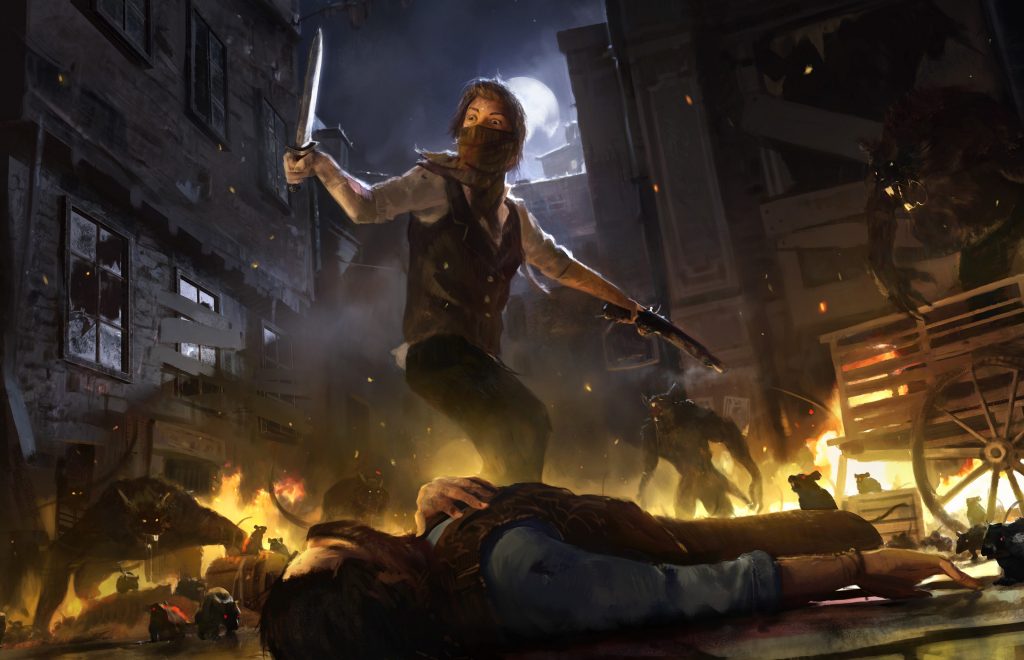
Richemulot, domain of Disease, Isolation, and Wererats. C’mon… let me LEAVE… please… This domain is something of a disaster movie as the “Gnawing Plague” sweeps through the entire plane over and over and over. It’s hard to tell a story of plague and desolation like this in 5e D&D because so many classes have access to the ability to touch people on the nose and cure pretty much anything multiple times a day. But, as was said earlier, “the rules don’t apply in dread domains.” There’s a cool map by Mike Schley (who did maps for Curse of Strahd), and interesting random encounters that are based on the character’s disease progression (stage 1-4). The art is thematic and wonderful, the setting is great, but a very simplistic Adventurers chart leaves this setting feel focused more on style than substance. Situated between the video games Dishonored and A Plague Tale: Innocence, this might be a good starting point if you enjoy those offerings.
Tempest, domain of Nature’s Cruel Secrets. How many have we done, now? Tempest is a pretty cool domain with another huge and really detailed map. It’s the first Folk Horror setting and is keyed around fey bargains, quaint villages, and hags that twist and unsettle otherwise idyllic locations. There’s a central festival called The Tithe that can spark a few interesting sessions, and a good bit of information about Viktal, the central location, but it’s robbed of a lot of forward narrative thrust by the culmination of a big fight with a monster. Great art and a totally unique premise when compared to the other domains may draw your interest, particularly if you enjoy Fey.
Valachan, domain of the Hunter. A jungle domain, Valachan is unique in the fact it’s a battleground in which visitors are hunted by the Dark Lord. It’s one giant hazard that must have came form the mind of a Jumanji fan. That’s not meant to be a dismissive statement, as I think this domain does quite a few things right. It thrusts a direct opposition onto the party, and adventures in the domain are secondary to the idea of being hunted by packs of displacer beasts and the weretiger Dark Lord in something called the Trial of Hearts. This domain, along with Falkovnia make for the best backdrops for campaigns and long-form adventures. Their base premise is essentially ever-present.

We did it, friends and enemies. We did all SEVENTEEN domains. My reaction the first time I skimmed the book was “there are too many.” My reaction now that I’ve read and summarized every one of them is: there are far too many domains. I’m not even going to talk about the additional twenty-two domains that are little more than a paragraph or two.
Every domain has style and an interesting idea or two, they all have merit and I can tell the writers tried their best, but why on earth there are SO MANY crammed into 106 pages is beyond me. I made the comparison on Twitter moments ago that the book doesn’t feel like a skeleton to build off of, it feels like a big pile of organs and meat – leaving you feeling unsure what the final version is supposed to look like. Is it an elk or a human? What in the world is this part and why is it moving?
There’s so many great ideas hidden in these tightly packed lines and overviews, but each and every domain left me wondering what could have been if the book chose to focus on 6. Any six of these domains of dread given 17 pages could have been a SHOWSTOPPING resource for any DM. As it stands, these domains are too sparse to help fledgling DMs who need more resources to run a game properly and are too slight for seasoned DMs who buy these books to broaden their toolkit and take worthwhile plots from. Great ideas can inspire, which is wonderful, but this entire chapter brings a sour taste to my mouth, as it seems more like a vehicle to fold more writers (and more advertisers) into the release than it does a platform for them to showcase and tell dynamic and interesting stories in these pocket dimensions.
The Jam Study
If you have never read it, I urge you to look into a study conducted in 2000 by Sheena S. Iyengar of Columbia University and Mark R. Lepper of Stanford University. In their study, they prove that more options might draw more attention but six (6) potential options is the ideal number to actually get people to make a meaningful selection.
Travelers in the Mist
Since Chapter 3 is not done with us quite yet, there are blurbs about groups who travel the mist (like the Vistani) as well as short spotlights on a nine NPCs. Each NPC is given a list of piecemeal adventures to be used in whatever domain they may be found in – but depending on the domain you select and the story you choose to tell and the NPCs you choose to use and the plot hook you choose to focus on, and the Dark Lord you choose to develop, and the setting you choose to flesh out, the additional NPC you choose to involve may or may not be a good fit – there’s just so many moving parts it’s hard to gauge how well each person could work on their own or together.
Chapter 4: Horror Adventures
This section may be the most useful and usable in the book, as it gives the DM a toolkit to actually run horror adventures, including a pre-game list of content questions to help avoid or include specific phobias, fears, or topics.
The first six pages explain some good ideas for running the game, establishing a creepy tone, setting the mood at the table, and caring for your players in a way that ensures the game doesn’t get too dour, disturbing, or depressing. It also mentions,for the first time ever, I think, running the game for people online through video chat – which is pretty cool.
The Horror Toolkit, which starts on page 192, gives a lot of piecemeal stuff you can include in any horror adventure, not specifically Ravenloft: curses, traps, fear and stress, and survivors (as you’d see with movie and television tropes).
All of that, the entire toolkit, is wonderful. I’d like to have seen that combined with Chapter 0 and Chapter 1, but I understand their decision to include it before the offered horror adventure The House of Lament.

The House of Lament
This is, sadly, another adventure meant to take the party from level 1 to level 3. There’s a whole lot out there, including Death House, but since 5e D&D is not designed to mesh with horror and fear all that well, it makes sense to give new DMs an introductory adventure to run utilizing the ideas in the book.
The adventure itself is about a haunted mansion with a particularly bloody and violent past. Characters are brought through the Mist to the home, overseen by a Dark Power, and are brought on to investigate the mansion and figure out what happened to the previous occupants. They’re more or less trapped inside and have to conduct seances to discover the truth and figure out who their true enemy is and how to escape with their lives.
Overall, it’s a tried and true adventure framework that’s… well, a lot like Death House, which is a lot like Arganvostholt, which is a lot like the Amber Temple, which is a lot like Castle Ravenloft. That’s not to say it’s poorly written or ill conceived, that’s not even to say I don’t like it – just that we’ve seen a haunted house/castle full of specters and ancient dead that’s difficult to leave quite a few times in 5e. It’s been a staple horror genre for centuries and is familiar to almost everyone, so I can’t fault it too much!
Chapter 5: Monsters of Ravenloft
This chapter has three full pages of DM suggestions, such as how monsters employ tactics, traits monsters can have, how to embed horror into creatures, etc – but not much in the way of mechanical tools, fitting to the books ideas of theme and emotion instead of numbers and abilities.
The bestiary contains a total of 32 creatures (12 with a CR of 3 or less, 20 with a CR of 4 or higher). They all seem serviceable, though there is a noticeable down-tick in the amount of flavor text, history, tactics, and lairs for these creatures compared to Volo’s Guide to Monsters and the Monster Manual. Many of the pages are left 1/4th or 1/3rd empty, favoring pretty sizable stat blocks and 2-3 small paragraphs about the creatures themselves. Not an inherently bad thing, just a thing.
I think some of these creatures are cool, but most of them seem pretty niche (like the Priests of Osybus or the Ulmist Inquisitors) but everything seems in order otherwise and many of the stat blocks are very potent, perhaps more-so than intended. I doubt anyone will be upset at more officially released creatures to hurl at the wood-chipper you call a party.
Dark Lords? Hello? Are… are you hiding?
However, I am completely BAFFLED why each of the dark lords did not get a stat block when things like the wereraven, and swarm of magggots/swarm of scarabs were included (we got wereravens in Curse of Strahd and Swarm of Insects functions almost identically to the two included swarms other than included diseases. Perhaps it’s because they included 17 domains, even more than 17 Dark Lords (as many domains had 2+). Instead of having a full stat block to reference, they are given suggestions like “vampire,” “knight,” or “spy” with qualifiers after “but a powerful spellcaster.” Again, the scope of SO MANY domains is just so incredibly wide, it chokes a lot of potential out of the book.
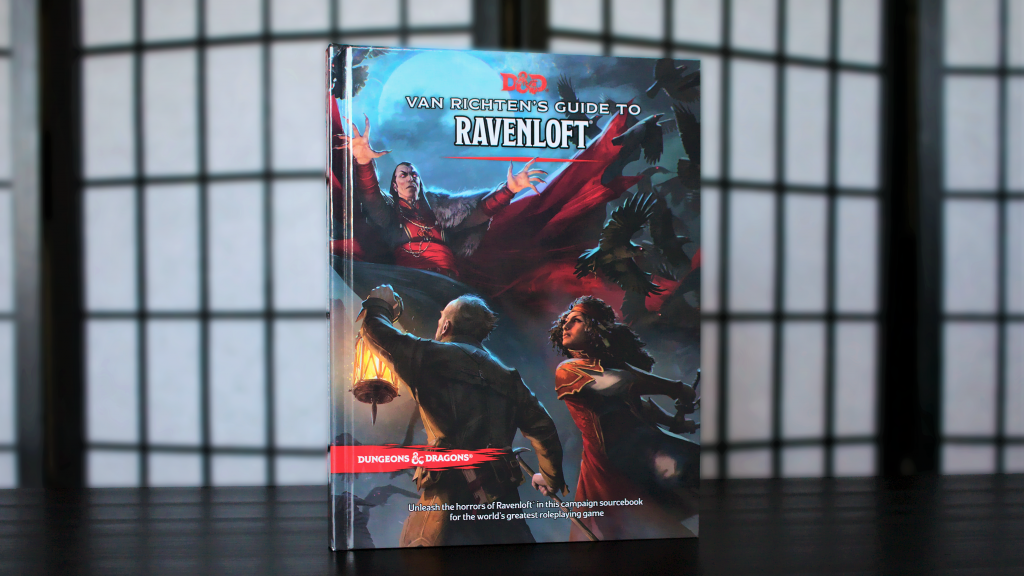
Final Thoughts
This book was torturous to review. Every single section I was left wanting MORE, and not in a good way. In the same way that Storm King’s Thunder packed 300+ locations into a single chapter, this book attempted to build 17 completely unique WORLDS in an average of 6 pages each. There’s just no way to fit it all in.
If I could snap my fingers and change the book, I’d completely delete the 22 additional domains that are so brisk as to be little more than a single idea (“what if a domain was full of terminator robots?”), cut half the length of chapter 1 and chapter 4 and combine them, and do 6-8 domains in their place. Include a Dark Lord stat block in each domain, and give us a 3-page index at the back of the book. Each Dark Gift could be 1/10th the length it is (like we saw in Curse of Strahd) and be functionally identical to what we have here, too. Include a BUTT LOAD of those, instead – since they’re so peculiar and cool.
Heck, you could even offer the subclasses as a free release, like they did with spells and races from Elemental Evil – because the two of them are only 3.5 pages and just “pretty good” to my jaded eye.
“rude…”
This review probably sounds incredibly negative and strained, and that’s probably because it’s how I feel. When I compare this book even to Ghosts of Saltmarsh I feel like getting a headache at just how brisk and underdone everything feels.
If Wizards of the Coast is prioritizing including more writers, having more piecemeal sections, and leaning on those writers to advertise and promote the book to their audiences, that will feel like a huge misstep in terms of integrity, even if it’s a machine to print money. I hope that’s not what we’re seeing, but ever since Descent into Avernus I’ve noticed a more slapdash approach to these books that unsettles me greatly.
- If you want a lot of ideas to inspire your own work, this book is great.
- If you think you will write and publish your OWN adventures based on domains found inside this book – you’ll get a lot of use out of it.
- If you’re not a horror fan at all and have a group slathering for horror adventures, this is a good starting point.
- If none of the above sound like they’re you – I cannot imagine this book being all that useful to you.
Lets collectively cross our fingers and hope to see the DMs Guild EXPLODE with new titles inspired by this book. It may be another vehicle to make boat loads of money from content creators, but it would be a lovely ripple made by this book’s lackluster splash.
I don’t always advocate rolling, but when I do… be sure you have to Drop the Die.
Review by JB Little, Follow me on twitter for more “useful” information.

